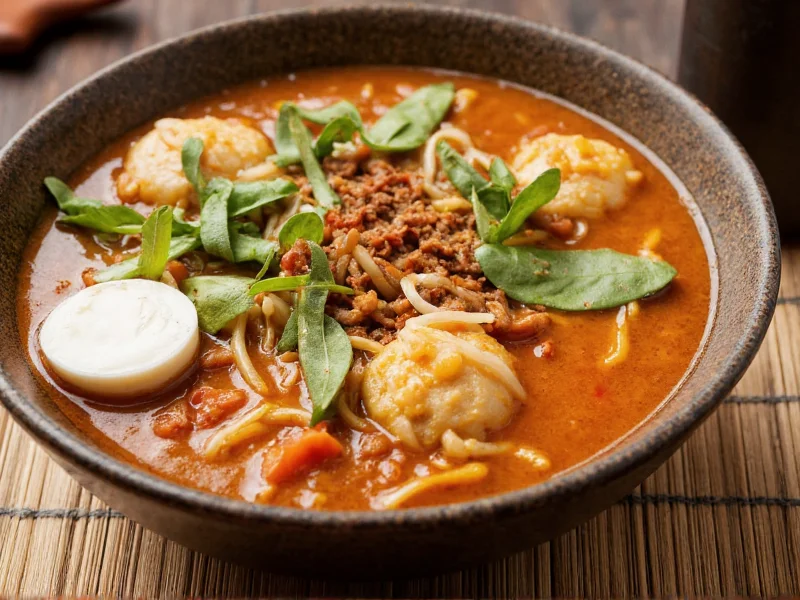For food enthusiasts seeking to explore global comfort foods, noodle soup dishes represent one of the most diverse and satisfying culinary categories. These meals transcend simple sustenance by offering complex flavor profiles and cultural significance that have evolved over centuries. Understanding what makes exceptional noodle soups requires examining their fundamental components and regional variations.
The Essential Components of Exceptional Noodle Soup Dishes
Every memorable noodle soup balances four critical elements that work in harmony. Mastering these components transforms ordinary meals into extraordinary dining experiences.
Broth Foundations
The broth serves as the soul of any noodle soup dish. Authentic preparations typically involve simmering bones, meat, or vegetables for extended periods—often 12-24 hours—to extract maximum flavor and collagen. Professional chefs emphasize the importance of skimming impurities during simmering to achieve crystal-clear broths with deep umami characteristics. For home cooks seeking quick weeknight noodle soup dishes, pressure cookers can reduce preparation time while maintaining flavor integrity.
Noodle Selection and Preparation
Noodle variety dramatically impacts the final dish's texture and mouthfeel. Different cuisines employ specific noodle types that complement their broths:
| Cuisine | Noodle Type | Key Characteristics |
|---|---|---|
| Japanese | Ramen noodles | Alkaline wheat noodles with firm texture |
| Vietnamese | Rice noodles (bánh phồ) | Thin, translucent rice vermicelli |
| Chinese | Egg noodles | Yellow, chewy wheat noodles |
| Italian | Pasta varieties | Egg-based noodles like pastina or orzo |
Proper noodle cooking technique proves equally crucial. Overcooking leads to mushy textures that can't properly carry broth flavors, while undercooking creates unpleasant chewiness. The best homemade noodle soup techniques involve cooking noodles separately and adding them to individual bowls just before serving.
Regional Noodle Soup Specialties Worth Exploring
Each culinary tradition has developed distinctive noodle soup dishes that reflect local ingredients and cultural preferences. Understanding these variations helps home cooks appreciate the diversity within this category.
Asian Noodle Soup Traditions
Asian cuisines feature some of the world's most complex and beloved noodle soups. Japanese ramen has evolved into a culinary art form with regional variations like Sapporo's miso-based broths and Hakata's rich pork bone tonkotsu. Vietnamese pho represents another pinnacle of noodle soup craftsmanship, requiring careful balancing of charred aromatics, spices, and delicate rice noodles.
For those interested in authentic Asian noodle soup recipes, attention to detail proves essential. Traditional pho preparation involves charring onions and ginger before simmering with beef bones and a specific spice blend including star anise, cloves, and cinnamon. The broth should be clear yet deeply flavorful, with meat that falls apart at the touch of a spoon.
European and American Interpretations
While Asia dominates noodle soup conversations, European traditions offer comforting alternatives. Italian stracciatella features egg-drop soup with spinach and Parmesan, while Jewish chicken matzo ball soup provides restorative comfort. American interpretations often blend traditions, creating innovative dishes like Korean-inspired short rib ramen or Thai curry noodle soups.
Creating Perfect Noodle Soup at Home
Professional-quality noodle soups remain achievable in home kitchens with proper technique and ingredient selection. These practical guidelines help elevate your noodle soup dishes from ordinary to extraordinary.
Broth Enhancement Strategies
Even when using store-bought broth as a base, home cooks can significantly improve flavor through simple techniques. Adding roasted bones, dried shiitake mushrooms, or kombu seaweed creates deeper umami notes. For gluten-free noodle soup options, ensure broth ingredients comply with dietary requirements while maintaining flavor complexity.
Ingredient Layering Principles
Successful noodle soups follow a logical ingredient addition sequence. Start with aromatics (onions, garlic, ginger), then build flavor with proteins and vegetables, finishing with delicate elements like fresh herbs and citrus. This layering creates dimensional flavor rather than a flat, one-note soup.
Dietary Adaptations Without Sacrificing Flavor
Modern dietary needs require thoughtful adaptations. For vegetarian versions, kombu and dried mushrooms provide umami depth traditionally achieved with meat bones. Gluten-free alternatives work well with rice noodles or certified gluten-free pasta varieties. The key lies in maintaining the essential balance between broth, noodles, and toppings that defines exceptional noodle soup dishes.
Final Considerations for Noodle Soup Excellence
Truly exceptional noodle soup dishes balance multiple elements: rich yet clear broths, perfectly cooked noodles, complementary proteins, and thoughtfully selected garnishes. The most memorable versions respect traditional preparation methods while allowing for personal interpretation. Whether exploring traditional Vietnamese pho preparation or creating innovative fusion dishes, attention to fundamental principles ensures satisfying results every time. Remember that patience with broth development and precision with noodle cooking separate adequate soups from extraordinary ones.
What's the secret to clear noodle soup broth?
The secret to clear broth involves simmering rather than boiling, which prevents emulsifying fats into the liquid. Skimming impurities during the first 30 minutes of simmering and avoiding stirring help maintain clarity. Starting with cold water and gradually heating extracts flavors without clouding the broth.
How can I prevent noodles from becoming mushy in soup?
Cook noodles separately until just shy of al dente, then add them directly to individual serving bowls before pouring hot broth over them. This prevents continued cooking in the broth. For meal prep, store noodles separately from broth and combine when serving.
Which noodle types work best for gluten-free noodle soup dishes?
Rice noodles, mung bean threads (glass noodles), and certified gluten-free pasta varieties work best. Rice noodles maintain texture well in hot broth, while glass noodles offer a unique translucent quality. Always check packaging for gluten-free certification to avoid cross-contamination.
How long should I simmer broth for optimal flavor?
For meat-based broths, 12-24 hours yields optimal flavor and collagen extraction. Vegetable broths require 1-2 hours. The ideal simmer maintains a gentle bubble where an occasional bubble breaks the surface, never a rolling boil which makes broth cloudy.
What are essential toppings for authentic Asian noodle soups?
Essential toppings include fresh herbs (cilantro, Thai basil), sliced green onions, bean sprouts, lime wedges, and chili peppers. Specific dishes feature unique elements: ramen includes marinated eggs and nori, while pho traditionally has thinly sliced raw beef that cooks in the hot broth.











 浙公网安备
33010002000092号
浙公网安备
33010002000092号 浙B2-20120091-4
浙B2-20120091-4